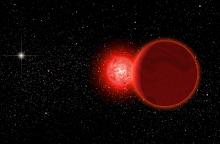Listen to today's episode of StarDate on the web the same day it airs in high-quality streaming audio without any extra ads or announcements. Choose a $8 one-month pass, or listen every day for a year for just $30.
You are here
Moon and Spica
One of the most famous of all skywatching directions is this: Arc to Arcturus, then spike to Spica. In other words, follow the arc formed by the handle of the Big Dipper until you come to the bright yellow-orange star Arcturus, which is high in the west at sunset now. From there, follow a straight line to Spica, the leading light of Virgo.
Tonight, there’s another way to find Spica: Look for the crescent Moon, low in the west-southwest at nightfall. Spica is close to the left of the Moon.
The best measurements put Spica at a distance of 250 light-years. That means the light we see from Spica tonight began its high-speed trip across the galaxy in 1773 — three years before the United States declared independence. That would make Spica a good “semi-quincentennial” star — marking America’s 250th birthday, in 2026.
Spica actually consists of two stars. They’re quite close together — so close that you need a special type of telescope to see them as individual stars. One of the stars is moving into its “giant” phase — puffing up to many times its previous size. Millions of years from now, it should blast itself to bits as a supernova.
The other star isn’t quite as massive as its companion, so it’s still in the prime of life. It should end its life in a more gentle process. But no one is sure how the evolution and explosion of the heavier star will affect the companion, so its future is a bit cloudy.
Script by Damond Benningfield






